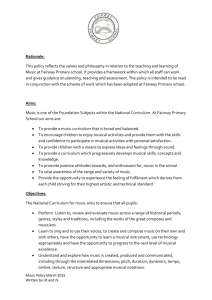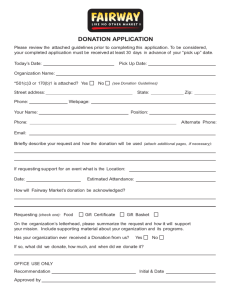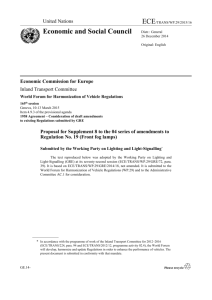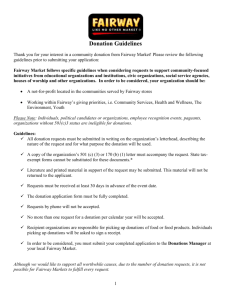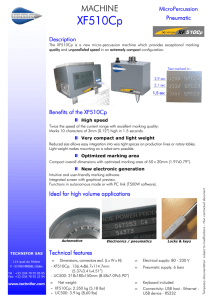Guidelines for Waterway Signs and Marking
advertisement
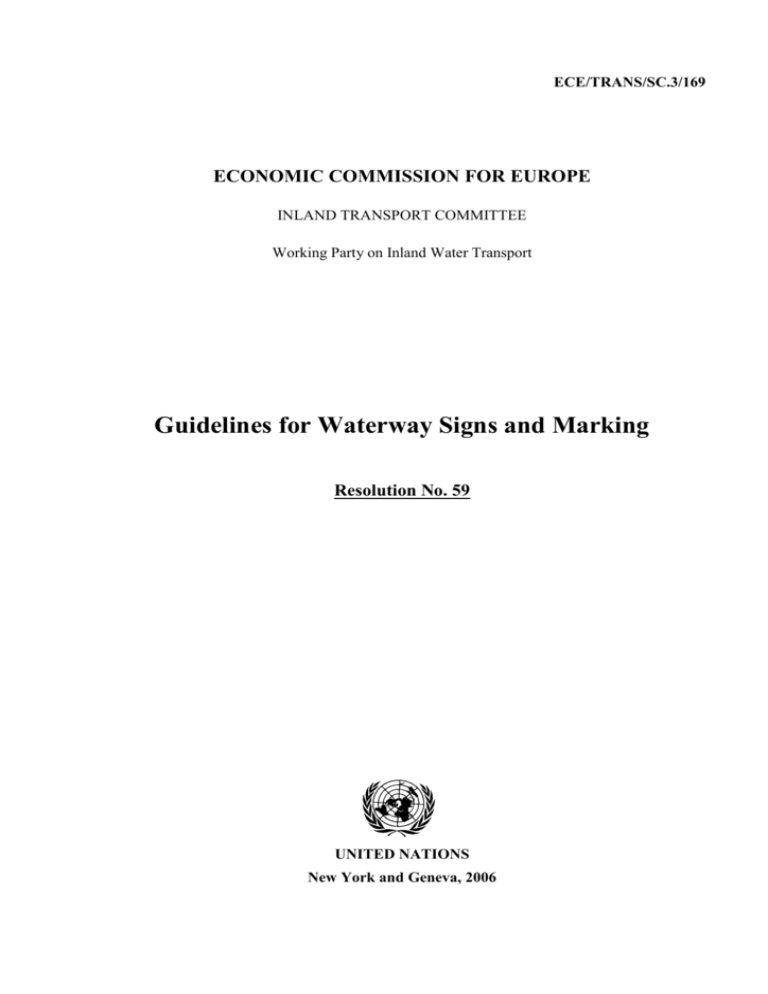
ECE/TRANS/SC.3/169 ECONOMIC COMMISSION FOR EUROPE INLAND TRANSPORT COMMITTEE Working Party on Inland Water Transport Guidelines for Waterway Signs and Marking Resolution No. 59 UNITED NATIONS New York and Geneva, 2006 ECE/TRANS/SC.3/169 page 3 Guidelines for Waterway Signs and Marking Resolution No. 59 (adopted on 20 October 2005 by the Working Party on Inland Water Transport) The Working Party on Inland Water Transport, Considering its resolution No. 24 concerning CEVNI: European Code for Inland Waterways, as amended by resolutions Nos. 26, 27, 37, 39, 43-47 and 54 (TRANS/SC.3/115/Rev.2), Considering also its resolution No. 22 concerning SIGNI: Signs and Signals on Inland Waterways, as amended by resolutions Nos. 29 and 51 (TRANS/SC.3/108/Rev.1), Bearing in mind the report of the Working Party on the Standardization of Technical and Safety Requirements in Inland Navigation on its twenty-eighth session (TRANS/SC.3/WP.3/56, paragraphs 22-23), Desirous, in the interest of safety of navigation, of establishing homogeneous rules for waterway signs and marking prescribed by CEVNI and SIGNI as well as for their visibility and installation, Decides to adopt the Guidelines for Waterway Signs and Marking the text of which is contained in the annex to this resolution, Requests Governments and River Commissions to inform the Executive Secretary of the Economic Commission for Europe whether they accept this resolution, Requests the Executive Secretary of the Economic Commission for Europe to place the question of the application of this resolution periodically on the agenda of the Working Party on Inland Water Transport. * * * ECE/TRANS/SC.3/169 page 4 Annex Annex GUIDELINES FOR WATERWAY SIGNS AND MARKING CONTENTS Page 1. GENERAL ..................................................................................................................... 5 2. REQUIREMENTS TO BE MET BY SIGNS AND MARKS AND THE PLAN FOR THEIR INSTALLATION ................................................................. 6 VISIBILITY OF SIGNS AND LIGHTS........................................................................ 8 Conditions of visibility and dimensions of signs ........................................................... Conditions for the visibility of lights ............................................................................. Obligation not to hinder road and rail traffic ................................................................. 8 9 10 INSTALLATION OF SIGNS AND MARKING IN CHARACTERISTIC SECTIONS OF THE RIVER ..................................................... 10 General ................................................................................................................. Marking of alluvial channels ................................................................................ Installation of cross-channel fairway signs and bank lights ................................ Installation of signs and signals on the water ...................................................... Marking of the vicinity of bridges and passages through bridges ....................... Installation of signs and signals on the water restricting anchoring points ......... Reference numbers on buoys and markers .......................................................... 10 12 12 12 13 13 14 IMAGE DISPLAY TECHNIQUES .............................................................................. 14 General recommendations ................................................................................... Light guide technology ........................................................................................ Light emitting diode (LED) ................................................................................. Electromagnetic segmented display ..................................................................... Rotary drum display ............................................................................................. Moving screens .................................................................................................... 14 15 15 15 16 16 INSTALLATION OF RADAR REFLECTORS ON MARKING SIGNS AND SIGNALS ............................................................................ 16 Appendix MEASUREMENTS OF BOARDS FOR SIGNS (example) .................................................. 19 3. 4. 4.1. 4.2. 4.2.1 4.2.2 4.3. 4.4. 4.5. 5. 5.1. 5.2. 5.3. 5.4. 5.5. 5.6. 6. ECE/TRANS/SC.3/169 page 5 Annex 1. GENERAL 1.1. In terms of the objective pursued, the marking comprises two categories of signs: signs used to regulate navigation on the waterway, set out in Annex 7 to the European code for inland waterways (CEVNI), and signs and signals on the water and bank marks marking the sides of the fairway and navigational hazards, set out in Annex 8 to the CEVNI. 1.2 The signs set out in Annex 7 to the CEVNI are prohibitory, mandatory, restrictive, recommendatory or informative signs and auxiliary signs. 1.3 In accordance with article 5.01 of the CEVNI, boatmen shall obey the requirements and take account of the recommendations or indications brought to their attention by these signs. 1.4. The signs and signals on the water and bank marks of Annex 8 of the CEVNI are used to indicate the limits, the direction and the depth of the waterway and, in addition, are used to mark obstacles and permanent structures in the fairway or in its vicinity. 1.5. The number of bank marks and signs and signals on the water and the plan for their on-site location shall meet the requirements of navigational safety. 1.6. The choice of the mark and the establishment of their number depends on the local characteristics of the waterway and the function of the mark. Their installation shall be effected in such a way as to ensure visibility from one mark to the next. 1.7. The luminous range of lights is established by the competent authorities of the respective countries in terms of local navigational conditions. In calculating the luminous range, the atmospheric transmission coefficient 0.6 should be used over a distance of 1 nautical mile. 1.8. In principle, the colours of lights should be in keeping with the recommendations of the International Commission on Illumination (“Colours of light signals”, in ICI publication No. 2.2 (T.C. 1.6) 1975). 1.9. The marks shall be installed by the competent authorities which: (a) regularly observe the state of the bed of the river and the changes taking place in it and, on the basis of the results of these observations, correct the positioning of the signs and marks and, where necessary, add to them so that they will indicate the fairway dimensions; ECE/TRANS/SC.3/169 page 6 Annex (b) regularly measure the depth and the width of the marked fairway and provide boatmasters with the necessary information concerning minimum channel depths and widths and the river level regime; (c) establish the plan for the installation of signs and marks in their respective sectors and establish the type and number of signs and signals on the water and bank marks to be used, in terms of the requirements of navigational safety and local conditions; (d) ensure the uninterrupted operation of all signs and signals on the water and bank marks; (e) inform boatmasters in good time of the date of the installation and removal of signs and signals, of all alterations to their number, type, positioning and lighting, and the rules they establish permitting the passage of vessels in restricted sections where meeting and passing are prohibited. 2. REQUIREMENTS TO BE MET BY SIGNS AND MARKS AND THE PLAN FOR THEIR INSTALLATION 2.1. Marking shall be in operation continuously (by day and night) all along the navigable section of the river, as from when the waterway is free from ice until the ice appears; it shall be corrected as changes occur in the level and in the fairway. 2.2. During periods of high water and icing, the regular marking removed to preserve it from possible damage shall be replaced, as far as possible, by marker posts and spars the topmarks and colours of which shall correspond to those adopted for the respective side of the fairway. 2.3. The bank marks and the additional signs and signals on the water shall, if possible, operate until navigation becomes completely impossible because of ice. 2.4. The positioning of the signs shall, as already said, be effected so as to ensure day and night visibility from one sign to the next. 2.5. Signs and signals on the water shall be installed so as to ensure the safety of vessels on the fairway. 2.6. Buoys shall be unsinkable and shall remain unsinkable in all storms, and their main body shall therefore be watertight; they shall not only float but also be stable, i.e. conserve a vertical position as far as possible and not be tipped excessively by waves and wind. 2.7. The basic condition which the plan for the installation of the signs and marks shall meet is to ensure the safety of the vessels and the continuity of traffic, by day and by night, throughout ECE/TRANS/SC.3/169 page 7 Annex the sailing season and to give boatmasters clear and unambiguous indications concerning the direction and the limits of the fairway. 2.8. The plan for the installation of the signs and marks shall be prepared in such a way as to permit a rational combination of bank marks and signs and signals on the water. When the plan is drawn up, it should be based on the conditions of navigation, and specific hydrographical and hydro meteorological conditions, the need to ensure the established dimensions of the fairway and create the necessary conditions for the safety and continuity of navigation of all river vessels and, where necessary, of seagoing vessels. 2.9. Bank marks serve to guide boatmasters and to indicate the direction of the fairway. Signs and signals on the water supplement bank marks in sectors where, in order to ensure the safety of navigation, it is essential to indicate not only the direction of the fairway but also its limits, and to mark places where there are obstacles. 2.10. In preparing the plan for the installation of signs and marking, the following requirements should be taken into account: (a) only the signs set out in Annexes 7 and 8 of the CEVNI are to be used to mark the fairway and regulate navigation; in exceptional cases, special additional bank marks may also be used, provided, however, that the marks are not in contradiction with those contained in the CEVNI; (b) the dimensions of the marked fairway shall correspond to the dimensions published by the competent authorities; (c) the choice of where the signs are to be placed shall be based on the most recent measurements, acquired experience and available data on the state of the fairway, critical points, water levels, etc.; (d) signs and marker lights shall be visible, whatever the level of the water, at all points of the fairway and as long as may be necessary for the guidance of boatmasters; 2.11. If there is a subsequent drop in the level of the water, reconnaissance soundings shall be taken on some sections of the river in order to check whether the positioning of the signs is adequate and to establish whether the marking needs to be supplemented by new signs. 2.12. The frequency of these soundings shall be determined by changes in water level. The more rapid the drop in levels, the more frequent the soundings need to be. ECE/TRANS/SC.3/169 page 8 Annex 3. VISIBILITY OF SIGNS AND LIGHTS 3.1. Whatever the position of the vessel in relation to the sign or the marker light, the characteristics of the sign or light shall remain unchanged. For daytime signs, these characteristics are: the form (topmark) and the colour; for signs and signals at night: the type and colour of the lights. 3.2. The forms and the colours of the topmarks and the types and colours of the lights are set out in detail in Annexes 7 and 8 of the CEVNI. 3.3. Sketches of the signs are given in the Appendix to these guidelines. The numbering of the sketches corresponds to the numbering of the signs given in Annexes 7 and 8 of the CEVNI. Conditions of visibility and dimensions of signs 1/ 3.4. The basic requirement to be met by signs and marking is the guarantee of good visibility of all signs and signals by day or night. 3.5. There are three degrees of visibility of signs and signals: (a) When, because of the distance, the sign is no more than a blotch on the background and neither shape nor colour can be distinguished (dotted outline); (b) When the sign is visible and its shape and outline can be seen, but the colour remains unclear; (c) When the shape and colour of the sign can be seen distinctly. 3.6. The degree of visibility of a sign, as of any object, depends primarily on the size of the angle of sight, the colour contrast, the contrast in luminance and weather conditions. 3.7. An example of the minimum measurements for the signs are given in the Appendix to these guidelines. Alphanumeric characters on traffic signs should intend to provide a standard for the various traffic signs. 3.8. As regards the signs and signals of Annex 8 of the CEVNI, unlighted buoys and unlighted bank mark boards shall be covered with reflective material. Light buoys and lighted bank mark boards may also be so covered. The colours of these materials shall correspond to those established for the buoy lights or the boards. In all cases, the topmarks of light buoys shall be covered with reflective paint. 1/ The competent authorities may provide for values of the height and width. ECE/TRANS/SC.3/169 page 9 Annex 3.9. In order to ensure that bank marks are clearly visible, their dimensions shall be determined in terms of their purpose, the distance between the fairway and the banks, the nature of the region and the characteristics or other specific conditions of the sector in question. 3.10. The good visibility of a sign or signal depends on the contrast between the luminance of the sign or signal and the background. This shall be taken into consideration in choosing a site for signs and signals. For example, of two boards, one red and the other white, positioned one beside the other against a light background, the red board will be more visible and visible at a greater distance than the white board while, in contrast, the white board will be easier to see than the red board against a dark background. 3.11. The visibility of signs and signals regulating navigation on the waterway shall be ensured at night by lighting them with fixed directional white lights, operating uninterruptedly and so positioned that the light does not incommode the boatmasters. 2/ 3.12. If electric lighting cannot be used, the sign boards shall be covered with reflective material of a corresponding colour on which the symbol shall be clearly visible to vessels. 3.13. Luminance and its regularity are also important from the point of view of the visibility of signs and signals. When boards are lighted, it should be ensured that the shade of their colour is unchanged. The luminance of the sign or signal perceived, like that of any object, depends not only on the lighting but also on the capacity of the surface of the sign to reflect the light waves falling on it. This shall be taken into consideration when the signs are painted; this shall be done in such a way that the surface of the sign is smooth and reflects the light properly and is not dull and covered with an uneven coat of paint. Conditions for the visibility of lights 3.14. The visibility of lights is determined by their strength and by weather conditions. 3.15. The equation set out in Annex 5 of the CEVNI may be used to establish the minimum luminous intensity required to obtain the desired visibility. 3.16. As has already been pointed out in the first part - General - the colours of the lights shall, in principle, conform to the recommendations of the International Commission on Illumination (“Colours of light signals”, in ICI publication No. 22 (T.C. 1.6) 1975). 3.17. Marking lights are fixed or flashing lights. The luminous range of flashing lights is less than that of fixed lights with the same luminous intensity. Flashing lights can nevertheless be 2/ The competent authorities may waive these requirements. ECE/TRANS/SC.3/169 page 10 Annex seen more easily and attract the boatmaster’s attention more readily, especially when surrounded by lights of neighbouring localities. 3.18. The duration of the flash of a signal light shall not be less than 0.5 seconds. Shorter flashes, even if they are frequent, are tiring on the boatmaster’s eyes and hinder orientation. Long and infrequent flashes on the other hand also hinder orientation, since while waiting for the next flash the boatmaster cannot be sure that he is still proceeding in the desired direction. 3.19. Details of the characteristics of signal lights used can be found in Annex 8 of the CEVNI. Obligation not to hinder road and rail traffic 3.20. Signs and marking shall be installed in such a way that their lights do not hinder the movements of other modes of transport if the road runs close to the river. 3.21. In a sector in which a road or a railway runs close to a river, the installation of all the above-mentioned signs and signals shall be carried out in consultation with the respective competent authorities. 4. INSTALLATION OF SIGNS AND MARKING IN CHARACTERISTIC SECTIONS OF THE RIVER 4.1. General 4.1.1. Signs have two possible orientations, namely: (a) parallel to the axis of the fairway; (b) perpendicular to the axis of the fairway. 4.1.2. Signs of type a. are predominantly prohibitory or indicative signs, and are placed on the side of the fairway to which the prohibition or the indication applies. 4.1.3. Most signs are positioned as described under b, and generally do not apply to one side of the fairway only. These signs are erected at right angles to the axis of the fairway so that they are visible to a user when under way. 4.1.4. The use of a particular sign or signal on the water or bank mark and how it is installed depends on the one hand on the local features of the river (speed of current, variation in levels, meanders, width of the bed, existence of sills, branches, islands, etc.), and on the other hand on the density of traffic in a given sector and the form and size of convoys. 4.1.5. The position of each sign or signal on the water indicating the side of the fairway shall be determined on the basis of the marking installation plan based on the results of measurements. ECE/TRANS/SC.3/169 page 11 Annex Depths within the limits of the width of the marked fairway shall under no circumstances be less than the minimum depth reported for the sector in question. 4.1.6. When signs and signals are installed on the water, it is essential to take the direction of the current into account. If the current flows in the direction of an obstacle, the sign or signal shall always be placed a long way from the navigational hazard (obstacle); if, on the other hand, it flows in the opposite direction, the sign or signal shall be placed nearer. 4.1.7. Obstacles on the sides of the fairway are always marked with signs or signals on the water. When the obstacle is indicated by a single sign, it shall be placed on the downstream extremity of the obstacle, on the channel side. 4.1.8. As a rule, lighted buoys or unlighted buoys shall be used to mark the upstream and downstream extremities of sills, banks which narrow the fairway, alluvial channels, banks protruding into the fairway, piles of stones, reefs, water supply engineering structures, and underwater hazards or obstacles (sunken vessels, anchors, etc.). 4.1.9. Marker posts and spars shall be used as additional signs supplementing buoys in order to give a clearer indication of the limits of the fairway over difficult sills and in order to mark underwater obstacles. In some cases and in some sectors, buoys may be replaced by marker posts or spars. 4.1.10. In order to avoid damage to buoys during the period when ice is carried down, they shall be replaced by spars or marker posts. 4.1.11. On sectors of the river where there is day and night navigation, forks, junctions and the centerline of the fairway, along with obstacles to navigation lying within the fairway, shall be marked by light buoys or bank lights. Signs and signals on the water shall be installed at such a depth and at such a distance from the obstacle that the safety and ease of movement of vessels shall be guaranteed at night and in poor visibility. 4.1.12. On sectors where the fairway is narrow, preference shall be given to marks on the banks. 4.1.13. Each sign or signal on the bank shall be established following reconnaissance of the area and selection of the most appropriate site. The need to ensure the visibility of the sign whatever the level of the water should be taken into consideration. 4.1.14. Where it is necessary to ensure good visibility of the symbol on the sign over a long distance, both for vessels proceeding upstream and vessels proceeding downstream, two boards may be installed on the sign pole at an angle to each other, one pointing upstream and the other downstream. ECE/TRANS/SC.3/169 page 12 Annex 4.1.15. In selecting the site of a sign or signal on the bank, account shall be taken of the need to ensure easy maintenance and to protect it against ice and flooding. 4.1.16. Before a bank sign or signal is installed, the depth in the area in front of it and in the direction it indicates shall always be measured. 4.1.17. As a general rule, the objective is that only the network of signs and signals on the bank shall provide an uninterrupted indication of the position of the fairway as a whole, while the signs and signals on the water shall help boatmasters to determine the limits of the channel. 4.2. Marking of alluvial channels 4.2.1. Installation of cross-channel fairway signs and bank lights 4.2.1.1. Cross-channel fairway signs and bank lights may be used in alluvial channels in order to indicate that the fairway crosses over from one bank to the other (signs featured in B.1, B.2, B.3, B.4 in Annex 8 of the CEVNI). 4.2.1.2. Alluvial channels are marked by bank lights and cross-channel fairway signs when the fairway is sufficiently broad, its safety is ensured, and when the direction only requires to be indicated approximately. 4.2.1.3. Bank lights and cross-channel fairway signs shall be selected in such a way as to differentiate cross-channel fairways in terms of their length, in other words in terms of the distance between two neighbouring signs. The length of the cross-over is relative, since it depends on the width of the fairway. 4.2.2. Installation of signs and signals on the water 4.2.2.1. In sectors of alluvial channels, where the channel passes along the middle of the river bed, or along the bank or passes slowly from one bank to the other, signs and signals on water are used to mark formations in the river bed or obstacles, both natural and artificial, on the sides of the channel (banks, shores, islands, stones, sunken vessels, wrecks of bridges, etc.), when these obstacles protrude into the fairway and reduce its width. 4.2.2.2. These underwater obstacles are marked in sectors of alluvial channels by signs and signals on the water if, within the limits of width indicated above, the depth of water over such obstacles does not exceed the minimum depth reported for the sector. If the obstacle is not very wide a light signal shall be installed on the water on its upstream section. A marker post or a spar may be installed on its downstream section, depending on its length. 4.2.2.3. The signs and signals on the water marking underwater obstacles of considerable length are installed in such a way that the parts situated closest to the channel are marked by light ECE/TRANS/SC.3/169 page 13 Annex signals between which unlighted signs are placed, thus enabling a given obstacle to be marked completely. 4.2.2.4. In the parts of the river bed where the shore opposite that followed by the channel is bordered by an inshore bank which favours upstream navigation in calm water, the bank is marked by signs and signals on the water independently of the width of the bed. 4.2.2.5. In sectors of alluvial channels, the bank marking system in periods of high water generally remains the same as in periods of lowest water level, except in sectors where, when water levels are high, it is advisable to find another channel with better navigational features. In this case, the selected channel shall be marked appropriately. 4.3. Marking of the vicinity of bridges and passages through bridges 4.3.1. The navigation of vessels and towed or pushed convoys in the vicinity of bridges and through bridge passages requires particular attention and precautions on the part of boatmasters because of the narrow fairway. These sections must therefore be marked with the greatest care. 4.3.2. The basic condition to be met to ensure safe passage through bridges is the marking of the direction of the fairway and also, where necessary, its sides. Signs and signals on the water and on the banks may be used in addition to boards and lights for marking the navigable passage through bridges. 4.3.3. The choice and positioning of the signs depends in each case on local conditions in the bridge section. 4.3.4. The installation of marking signs in the vicinity of bridges and the buoying of navigable passages shall comply with the following conditions: (a) in order to indicate permission to use the navigable passage of a bridge, only signs A.10, D.1 or D.2 in Annex 7 of the CEVNI shall be used; (b) the installation of marking signs shall be based on depth and current direction measurements, both in the immediate vicinity of the bridge and in the approach sections; (c) the positioning of the signs installed in the vicinity of a bridge shall be modified in due course, as conditions of navigation change; (d) if, when approaching the bridge or the navigable passage, the direction of the current forms an angle with the bridge, giving rise to eddies around the pillars of the bridge, the signs on the water shall be so installed as to indicate the direction of the eddies. ECE/TRANS/SC.3/169 page 14 Annex 4.3.5. Signs and signals may be installed on the water at the approach to the navigable passage to give an exact indication of the position of the channel. 4.4. Installation of signs and signals on the water restricting anchoring points 4.4.1. Where there is increased intensity of vessels’ traffic and the substantial accumulation of vessels in inner harbour basins of ports, not only signs and signals on the banks should be used in order to restrict berthing places but also signs and signals on the water. 4.5. Reference numbers on buoys and markers 4.5.1. On buoys and markers the use of alphanumeric characters and capital letters is recommended. Where both letters and figures are used, their heights should be the same. Where two such combinations occur, as on junction markers, a hyphen should be used. 4.5.2. Characters should not be less than 200 mm high, white on red or green buoys, or black on yellow buoys. 4.5.3. The characters on a lighted buoy can be black on a white background. Signs are usually affixed to special nameplates. It is recommended that the characters be displayed on both sides of buoys. 5. IMAGE DISPLAY TECHNIQUES 5.1. General recommendations 5.1.1. New image display techniques have come onto the market. These may be used subject to a number of conditions. It is generally recommended that when these new image display techniques are used: (a) the technique must comply with the provisions of the CEVNI; (b) deviation from the original colours is possible for some signs when implementing a new technique. This is dealt with in the descriptions of the relevant signs; (c) because new display techniques sometimes make use of images composed of many pixels, special consideration needs to be given to image design; (d) a general characteristic of the new display techniques is that the text and images can be controlled remotely; variable images are possible within a single display. Phantom effects, i.e. reflective effects and illusions caused by the incidence of sunlight, can be controlled. ECE/TRANS/SC.3/169 page 15 Annex 5.2. Light guide technology 5.2.1. Light guide technology, is mostly familiar from the matrix signalling devices positioned above roads. The images are displayed on lens arrays, linked by means of fibre optics (glass or plastic cable) to an optical device with, usually, a main and a back-up light. Every image is controlled from one or more optical devices. By switching the different optical devices on and off, different images, and therefore variable information, can be displayed. Advantages: - no mechanical/moving parts low maintenance high luminous intensity (adjustable) high-fidelity imaging all-weather socket can be located accessibly Disadvantages: - relatively costly - limited number of images 5.3. Light emitting diode (LED) 5.3.1. A LED is a small low voltage light source. Its visibility is limited by its angular aperture and the luminance of the LEDs. Images are made up of a large number of LEDs, each controlled separately. In other respects its properties are very similar to those of light guide technology. Advantages: - no mechanical/moving parts low maintenance simple control high-fidelity imaging Disadvantages: - limited range of display colours - Light output affected by ambient temperature 5.4. Electromagnetic segmented display 5.4.1. Application of an electromagnetic segmented display. Any desired image can be displayed by reversing electromagnetic segments, one side of which is light and the other dark in colour. The angular aperture on these displays is wide, both horizontally and vertically. Advantages: - presentational flexibility displays in all colours easy to read low energy usage continues to display last image if power fails Disadvantages: - displays must normally be kept in a conditioned cabinet because of moving parts ECE/TRANS/SC.3/169 page 16 Annex - lighting required when dark 5.5. Rotary drum display 5.5.1. Rotary drum displays are suitable for displaying regularly changing configurations. Advantages: - IWPR configuration can be accurately reproduced - displays in all colours - good visibility Disadvantages: - mechanical parts, so maintenance facilities necessary - number of images limited - lighting required when dark 5.6. Moving screens 5.6.1. Moving screens can consist of a display with a large number of light dots (LED or bipolar segments), switched so as to form arbitrary texts or diagrams. The text can also move, allowing a message of virtually unlimited length to be displayed. Advantages: - flexible, unlimited displays - no moving parts - all-weather Disadvantages: - monochrome - relatively expensive 5.6.2. Application: information on waiting times, operating times, etc. 6. INSTALLATION OF RADAR REFLECTORS ON MARKING SIGNS AND SIGNALS 6.1. Inland navigation vessels increasingly use radar in order to ensure their orientation in conditions of poor visibility (fog, overcast weather, snow, showers, etc.). These installations are of great importance for the safety of navigation, particularly in autumn and winter. 6.2. The experience of vessels navigating with the help of radar shows that signs and signals on the water which are not equipped with radar reflectors do not have a sufficiently strong reflection to be clearly seen on a radar screen. It is important to equip signs on the water and on the banks with radar reflectors to ensure their visibility. 6.3. When marking signs equipped with radar reflectors are installed, account must be taken of the furthest distance between the vessel and the sign in terms of the perception of the sign on the radar screen. This distance is not always the same, but depends on the technical characteristics of the radar equipment, the radar reflectors and the specific conditions of the river ECE/TRANS/SC.3/169 page 17 Annex and the height of the antenna installed on the vessel, as well as the height of the radar reflector in relation to the water. 6.4. Vessels and other objectives and objects floating on the surface of the water can be perceived and distinguished on a radar screen as clearly separate from each other depending on the technical characteristics of the radar equipment, the distance to the objective, the distance between objectives, etc. Generally speaking, at a distance of 1 km two objects are perceived as clearly separate from each other when there is approximately 15 m between them. 6.5 From experience, bridge passages and pillars are not always sufficiently visible on the screen. In order to ensure danger-free passage through bridges, buoys equipped with radar reflectors should be placed on both sides of the passage, not less than 15-20 metres upstream and downstream from the bridge, or passages through bridges should be marked with radar reflectors installed on the bridge itself. 6.6. Since radar reflectors are extremely reliable, every effort should be made to install them by means of supports on the framework of bridges to mark the navigable passage through the bridge. 6.7. Navigational hazards and water supply engineering structures (sunken vessels, groynes, cross-beams, etc.) located in the river bed may also be marked by signs equipped with radar reflectors. If the groynes or cross-beams marked by radar reflector signals are located along one of the banks while the fairway follows the opposite bank, which is low and flat, the radar reflector signals may also be placed on that bank so as to facilitate the orientation of vessels navigating by radar. 6.8. In general, when radar reflectors are used on marking signs and signals, the rule that these reflectors shall not modify the form or size of the sign or signal should be observed. Their colour shall also correspond to the colour of the sign or signal in question. 6.9. The most common type of radar reflector is the so-called square octahedral reflector, i.e. a reflector with eight cavities. It is constructed of 3 flat square plates perpendicular to one another. The reflectors should be made of aluminium or stainless steel, and not painted so as to enhance reflectivity. 6.10. Practical experience has shown that there is a need for at least two standard sizes of reflectors on buoys and markers. Recommended dimensions are as follows. type 1: tip to tip height 420 mm type 2: tip to tip height 850 mm ECE/TRANS/SC.3/169 page 18 Annex 6.11. The square plate referred to above has a hypotenuse of 300 or 600 mm respectively and sides of 210 or 425 mm respectively. The reflector should be placed in the lying position to maximize its reflectivity. * * * ECE/TRANS/SC.3/169 page 19 Appendix Appendix MEASUREMENTS OF BOARDS FOR SIGNS (example) In principle, boards may be surrounded with a white strip 12 to 45 mm broad, or a black strip 10 mm broad in order to improve the visibility of the symbols appearing on special bank signs. Example of the measurements of marking signs A.1 and A.2 (in cm). b c H b a A.1. A Measurements in cm, in relations to the width of the fairway a b c H A 1.2 16.8 12.0 48.0 72.0 to to to to to 4.5 56.0 40.0 160.0 240.0 ECE/TRANS/SC.3/169 page 20 Appendix A. 2. 95 15 65 15 60o o 2 75 o 2,5 10 31 20 ________________
